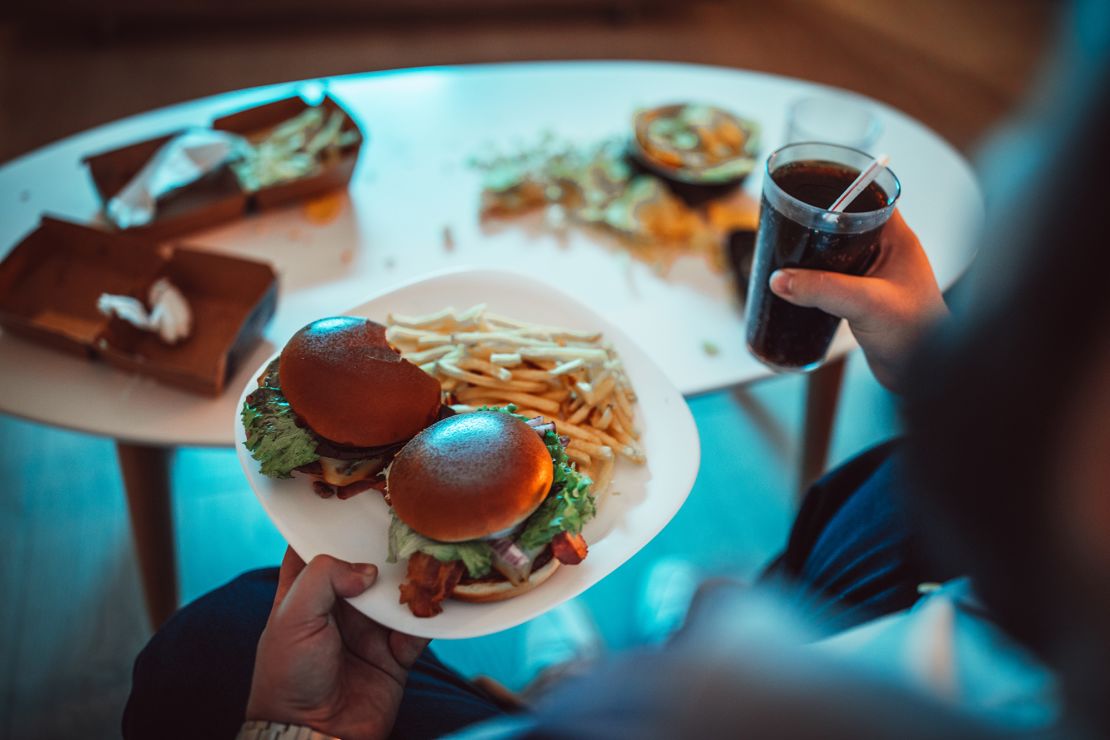CNN
—
Sign up for CNN’s Eat, But Better: Mediterranean Style. Our eight-part guide shows you a delicious expert-backed eating lifestyle that will boost your health for life.
Nearly 70% of all food in grocery stores in the United States is ultraprocessed, meaning the foods contain additives used to add flavor and color, create texture, extend shelf life and keep ingredients from separating.
Yet little research on the health impact of additives exist, and what data there is looks at the possible harms of individual ingredients, such as food dyes and brominated vegetable oil, as well as contaminants that leach into foods from packaging.
However, clusters of additives often used by industry in certain food categories may be more harmful when eaten together than alone, according to a new study which found two such mixtures linked to a small but significant increase in type 2 diabetes.
“The research shows that the intake of certain clusters of additives increases the risk of diabetes beyond the effect of each individual additive,” said Carlos Augusto Monteiro, emeritus professor in the school of public health at the University of Sao Paulo in Brazil, in an email.
“The fact that the regulation of additives considers their effect on health individually, rather than as part of a combination, has been criticized because these additives are consumed in clusters, not alone,” Monteiro said. “The research demonstrates that this criticism is absolutely valid.”
Monteiro, who was not involved in the study, created the often-used NOVA classification system, which groups food by levels of processing. Foods in their natural state, such as fruits, vegetables, meat, milk and eggs, are considered unprocessed or minimally processed.
Salts, oils and spices are processed cooking ingredients. Canned vegetables and fruits, breads and cheese are considered processed. Packaged and ready-to-eat foods, processed meats and sugary and diet drinks that contain additives never or rarely used in kitchens and that undergo extensive industrial processing are considered ultraprocessed.
The International Council of Beverages Associations, which represents industry, told CNN via email the study was “absurd.”
“This study’s claim is highly misleading and only serves to instill fear and confusion among consumers. Decades of robust scientific evidence show these ingredients are safe,” said ICBA Executive Director Kate Loatman.
Additives often used in ultraprocessed foods include preservatives to resist mold and bacteria; emulsifiers to keep incompatible ingredients from separating; artificial colorings and dyes; fragrance and flavor enhancers; anti-foaming, bulking, bleaching, gelling and glazing agents; and added or altered sugar, salt and fats designed to make food more appealing.
Industry often combines the same additives over and over in a particular type of food because they have complementary properties, said senior study author Mathilde Touvier, director of the Nutritional EpidemiologyResearch Team at the French National Institute for Health and Medical Research, a public research organization.
“A diet soda will contain a mixture of artificial sweeteners, dyes, and acidifiers such as aspartame, acesulfame potassium (Ace-K), sulfite ammonia caramel, and citric acid,” said Touvier via email. “Same for a flavored diet yogurt — with emulsifiers and artificial sweeteners — or an industrial bread with emulsifiers, preservatives, etc.”
In addition, people often eat certain foods together, thus creating unique groups of additives, said Touvier, who is also the principal investigator of the NutriNet-Santé cohort, a long-term study of the relationship between nutrition and health.
Take a regular fast-food consumer who eats a typical meal of a burger on an industrial bun, fries and a soda, or a hot dog on industrial bread with chips and soda. Eating the same ultraprocessed foods together on a regular basis can contribute to creating these clusters of chemicals, she said.

The new research, published Tuesday in PLOS Medicine, analyzed nutritional and health data of over 108,000 adults participating in the French NutriNet-Santé study. Prior studies using this population uncovered an association between artificial sweeteners, emulsifiers such as polysorbate 80, carrageenan, xanthan and guar gum, and the nitrates found in processed meats with an increased risk of type 2 diabetes.
Participants were asked about their dietary intake by brand at the start of the study by using the Open Food Facts database, a listing of the ingredients, allergens and nutrition facts of over 3 million foods from 150 countries by commercial brand name. Knowing the nutritional and ingredient list for each food allowed the researchers to build a database of known additives eaten by each person.
“These mixtures are data-driven,” said first study author Marie Payen de la Garanderie, a doctoral student in the Nutritional Epidemiology Research Team at the French National Institute for Health and Medical Research.
“We did not decide ‘a priori’ to group additives together. These 5 mixtures reflect the ones most frequently ingested by NutriNet-Santé participants,” de la Garanderie said in an email. “This study is the first to estimate exposure to food additive mixtures in a large cohort of the general population and to analyze their link to the incidence of type 2 diabetes.”
Nutritional data was then compared to medical records through December 2023 to see who developed type 2 diabetes.
“We carefully adjusted all models for intakes of energy, added sugars, saturated fatty acids, sodium, dietary fiber, etc., in order to isolate a potential effect of the studied mixtures, independently from the well-known effect of sugar on type 2 diabetes,” Touvier said.
Of the five clusters of additives, two were associated with a modest increase in a risk for diabetes, regardless of the nutritional quality of the diet, or sociodemographic and lifestyle factors.
The first cluster consisted of modified starches, pectin, guar gum, carrageenan, polyphosphates, potassium sorbates, curcumin and xanthan gum. Xanthan and guar gum are derived from plants and are typically safe, even beneficial, according to some studies. However, other studies have found disruptions in gut microbiota and inflammation.
Foods in this cluster would include creamy dairy desserts, such as ready-to-eat puddings, fat-based sauces such as cheese dip, and broths.
“Modified starches is a group of phosphate additives,” said Elizabeth Dunford, an adjunct assistant professor in the department of nutrition at the University of North Carolina at Chapel Hill, who was not involved in the study.
“There is a plethora of research to show the detrimental effect phosphate intake has on kidney function, and it is most certainly linked to negative effects in type 2 diabetes,” Dunford said in an email.
The second cluster linked to an increased risk for type 2 diabetes included citric acid, sodium citrates, phosphoric acid, sulfite ammonia caramel, acesulfame potassium or Ace-K, aspartame, sucralose, Arabic gum, malic acid, carnauba wax, paprika extract, anthocyanins, guar gum and pectin. These additives are typically found in sugary and artificially sweetened drinks.
“One of the clusters contains several emulsifiers, while the other contains several non-sugar sweeteners — both groups with individual components whose association with diabetes was already demonstrated, so findings are very consistent,” Monteiro said.
Much more research needs to be done to gain a “deeper understanding” of potential interactions of food additive mixtures on metabolism, de la Garanderie said.
“The research appears thorough,” Dunford said. “I think this paper is a good first step to highlighting the potential negative health consequences of specific additive combinations.”

